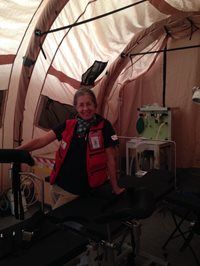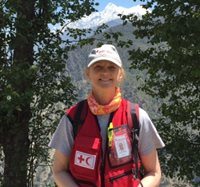.jpg.aspx;.pdf;?width=200&height=200) “I would do it all over again,” said Sarah Mutch, a Canadian Red Cross aid worker who was deployed with the field hospital following the devastating earthquake in Nepal.
“I would do it all over again,” said Sarah Mutch, a Canadian Red Cross aid worker who was deployed with the field hospital following the devastating earthquake in Nepal.
Every disaster brings its own unique challenges, and the way in which the Red Cross responds must be specifically tailored to each one. Being prepared, and understanding the geography and topography, as well as culture, are key in ensuring efforts are effective. The two earthquakes in Nepal on April 25 and May 12 are reminders of this.
Emergency Response
The Canadian Red Cross, with the support of the Government of Canada, has two health Emergency Response Units (ERU) on standby: a field clinic (also called Basic Health Care Unit), and a field hospital (also called Rapid Deployment Emergency Hospital). Following a major emergency, the preparedness, reliability and flexibility of this equipment allows for deployment anywhere in the world within 48 hours. They are fully self-sufficient for one month, and can operate for up to four months with supplies and a multidisciplinary team of 10 to 20 aid workers. Within 12 hours after arrival, an ERU can start providing health care services, including mother and child care, surgery, community health and psychosocial support, and treat up to 300 patients a day when fully functional.
 First Responders
Among the 20 Canadian Red Cross delegates who left for Nepal within 48 hours of the first earthquake were: Ola Dunin-Bell, surgeon (left); Diane Hyra-Kuzenko, operation theatre nurse (below); and Sarah Mutch, nurse (above) . They had one thing in common: this mission was their first experience with a Canadian Red Cross ERU deployment. When they landed in Kathmandu on April 28, it was to a scene of utter destruction.
First Responders
Among the 20 Canadian Red Cross delegates who left for Nepal within 48 hours of the first earthquake were: Ola Dunin-Bell, surgeon (left); Diane Hyra-Kuzenko, operation theatre nurse (below); and Sarah Mutch, nurse (above) . They had one thing in common: this mission was their first experience with a Canadian Red Cross ERU deployment. When they landed in Kathmandu on April 28, it was to a scene of utter destruction.
However, the Canadian team’s help was more urgently needed elsewhere. Found 150 km north by winding mountain roads, Dhunche is the administrative seat of Rasuwa,
one of the districts most affected by the first earthquake. The earthquake had destroyed the old district hospital, and the Nepalese Minister of Health requested the Canadian Red Cross field hospital (ERU) be set up next to its ruins.
“I would say the main difference between a first rotation and a regular field situation is that here we have to look after each other,” said Dr. Ola Dunin-Bell, a Canadian surgeon who has been with Red Cross for three years and specifically trained in emergency response. “From day one, we need to build living space, to make sure there is food and drinking water for everyone, while setting up the field hospital to provide medical assistance to the victims.”
Overcoming challenges
As the narrow roads leading to Dhunche had been blocked by rockslides, everything had to be flown in by helicopter. Ola, Diane and Sarah were quickly sent along with the first half of the Canadian aid workers and the medical equipment. In rugged mountain terrain at 2,030 metres above sea level, the Canadian team set up a field hospital overlooking the village and surrounded by distant mountains as high as 7,000 metres. The Canadian Red Cross field hospital in Dhunche features a full medical team that includes a surgeon, obstetrician, emergency medicine physicians, general practitioners, all working together with experienced technicians and a communications delegate. The team also supports doctors, nurses and health aid workers from the Nepali health system, who are still active in the community.
 “It’s impressive what a team of 14 people can accomplish in two weeks in a very chaotic environment,” said Diane Hyra-Kuzenko, who has 41 years experience as a nurse. Indeed, “Throughout the mission, , we managed to perform surgeries and provide health care to the communities. Common sense and creativity prevailed to meet all the challenges.”
The Canadian Red Cross has experience with deployment in difficult situations, such as the Haiti earthquake, the Philippines typhoon, and now the Nepal earthquakes. They are all different, but the success of an ERU deployment relies on the readiness to leave within 48 hours after a disaster, and on the quality, flexibility, and skills of its delegates. Ola, Sarah and Diane, highly qualified professionals, have a common motivation: “We feel a moral obligation to help look after those who are more vulnerable. That is why we are in the medical profession.”
The IFRC, the International Committee of the Red Cross and 26 National Red Cross and Red Crescent Societies now have teams in Nepal working in support of Nepal Red Cross and aid flights with emergency relief and medical materials are being mobilized every day.
Canadians are encouraged to support people impacted by this disaster by making a donation to the Canadian Red Cross Nepal Region Earthquake Fund
“It’s impressive what a team of 14 people can accomplish in two weeks in a very chaotic environment,” said Diane Hyra-Kuzenko, who has 41 years experience as a nurse. Indeed, “Throughout the mission, , we managed to perform surgeries and provide health care to the communities. Common sense and creativity prevailed to meet all the challenges.”
The Canadian Red Cross has experience with deployment in difficult situations, such as the Haiti earthquake, the Philippines typhoon, and now the Nepal earthquakes. They are all different, but the success of an ERU deployment relies on the readiness to leave within 48 hours after a disaster, and on the quality, flexibility, and skills of its delegates. Ola, Sarah and Diane, highly qualified professionals, have a common motivation: “We feel a moral obligation to help look after those who are more vulnerable. That is why we are in the medical profession.”
The IFRC, the International Committee of the Red Cross and 26 National Red Cross and Red Crescent Societies now have teams in Nepal working in support of Nepal Red Cross and aid flights with emergency relief and medical materials are being mobilized every day.
Canadians are encouraged to support people impacted by this disaster by making a donation to the Canadian Red Cross Nepal Region Earthquake Fund.